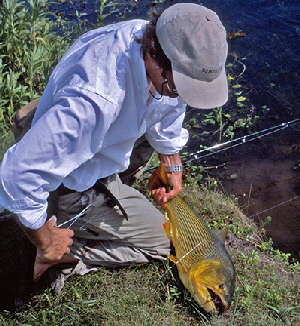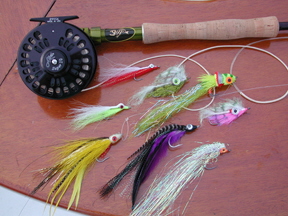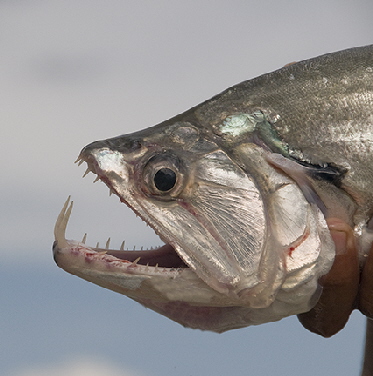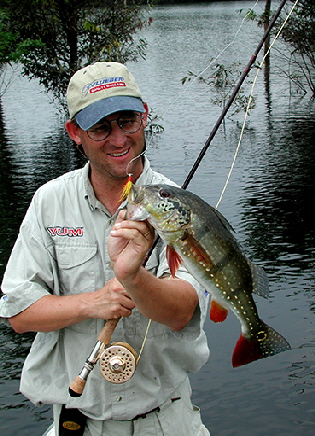|
Top 3 Warm Water South American Species on a Fly
By Larry Larsen
Want a challenge? Check out the river tigers, Dracula fish and tackle exploders! Three
fish in our Southern Hemisphere are certainly up for any battle. The golden dorado, payara and peacock bass are the strongest, most exciting fish swimming in the
Americas, according to those who have fished them. All three species eat piranha for dinner, which attests to their reputation as the toughest fish in their world where only
the strongest, fastest or deadliest survive.
Your equipment must be ready for the task when fighting any of the 3 voracious and
aggressive predators who all grow to 20 pounds and more. And you must be ready for a fish that can destroy your equipment and make you cry. They are strong, acrobatic and difficult to land.
 The freshwater dorado (Salminus maxillosus) is unique to south-central South America, including Argentina, Paraguay, Uruguay, Bolivia
and Brazil. The conquistadors, who ransacked South America looking for gold, reportedly gave the dorado its name, which means "golden." It is a member of the tenacious
-toothed Characidae family, and its relatives include both the payara and piranha. It has a massive head and a body sheathed in distinctive golden scales, appointed with
crimson-tipped fins and a unique tail with reddish black spot. The freshwater dorado (Salminus maxillosus) is unique to south-central South America, including Argentina, Paraguay, Uruguay, Bolivia
and Brazil. The conquistadors, who ransacked South America looking for gold, reportedly gave the dorado its name, which means "golden." It is a member of the tenacious
-toothed Characidae family, and its relatives include both the payara and piranha. It has a massive head and a body sheathed in distinctive golden scales, appointed with
crimson-tipped fins and a unique tail with reddish black spot.
Dorado prefer currents, and hang out in rivers or large marsh areas with any water movement. They are more active during
sunny times and generally feed in faster currents primarily on a variety of minnows and fingerlings. The "river tigers" hunt in schools or packs, and most fish in the pack are
of similar size to one another. They typically hover ahead of current breaks or ripples in rivers, approach their targets with a terrifying charge and then impart a crippling strike
when they engulf their prey. Their bear-trap jaws are lined with twin rows of razor-sharp teeth.
 Once hooked, they normally erupt through the surface and then may greyhound, sound or repeatedly cartwheel or twirl on their tails in the
skies. Their gills rattle loudly with each spray-flinging leap. It is difficult to stay buttoned to the fish, but most anglers may land about 50 percent of their hookups. Fly fishermen often
use deceiver flies, along with muddler minnows in colorful patterns (black and yellow and black and red) tied on 1/0 or 2/0 hooks. Ideal rods are 8-weight for the bigger runs and/or bigger dorado. Once hooked, they normally erupt through the surface and then may greyhound, sound or repeatedly cartwheel or twirl on their tails in the
skies. Their gills rattle loudly with each spray-flinging leap. It is difficult to stay buttoned to the fish, but most anglers may land about 50 percent of their hookups. Fly fishermen often
use deceiver flies, along with muddler minnows in colorful patterns (black and yellow and black and red) tied on 1/0 or 2/0 hooks. Ideal rods are 8-weight for the bigger runs and/or bigger dorado.
The savage payara (Hydrolycus scomberoides) is native to the northern half of South
America, primarily the vast Amazon and Orinoco watersheds. The most conspicuous characteristic of the silver-bodied payara are two sword-like teeth that protrude from
the lower jaw and fit into slots in the upper mouth. The tips of the fangs even protrude through the top of the fish's head when its mouth is closed. It has a tarpon-like body
and a fights even more.
The prehistoric-looking "Dracula" slashers are powerful fish that congregate in swirling
eddies, fast currents and rapids around large submerged rocks. Schools of menacing payara typically rip through schools of baitfish and strike out at any sardine-type forage
or look-alike within reach. Payara seldom feed on the turbulent surface, and they are difficult to hook on a fly. Large silver and white streamers tied on 2/0 and 3/0 hooks
and 9- or 10-weight rods work best.
 After a hook-up, the saber-toothed
gamefish will leap into the air 4 or 5 times and then make awesome runs down current that may rip off a couple hundred yards of line and backing. There is no stronger,
tougher fish in the world, so the angler should try to move it out of the main current. A hooked payara is certainly not necessarily a boated one, as they will often pull free.
When they close their mouth on the fly, it is difficult for the angler to set the hook because it is pinned inside the formidable dentures. After a hook-up, the saber-toothed
gamefish will leap into the air 4 or 5 times and then make awesome runs down current that may rip off a couple hundred yards of line and backing. There is no stronger,
tougher fish in the world, so the angler should try to move it out of the main current. A hooked payara is certainly not necessarily a boated one, as they will often pull free.
When they close their mouth on the fly, it is difficult for the angler to set the hook because it is pinned inside the formidable dentures.
The exciting peacock bass (Cichla temensis) originates and thrives in the Amazon waters of Brazil and the surrounding countries of
Venezuela, Colombia, Guyana, Suriname, French Guiana, Ecuador, Peru and Bolivia. The peacock's range overlaps some with the payara and minimally with
the dorado. The aggressive peacock bass prefers the quieter waters of lagoons and lakes off rivers, and is the largest American member of the cichlid family of fishes which
also includes 1,400 other species in the world.
 The peacock bass derives its name from the
large conspicuous, ocellated (ringed in gold) black halo spot on its tail, which resembles the vivid "eye" on the beautiful plume of a peacock's tail. The rainbow-like coloration
of the peacock bass is striking; the base main body color can be greenish-black, bronze and light white, golden to mellow yellow or light chartreuse to pink or blood
red. The biggest of the species normally has irregular broad and dusky black vertical bars along its sides. The peacock bass derives its name from the
large conspicuous, ocellated (ringed in gold) black halo spot on its tail, which resembles the vivid "eye" on the beautiful plume of a peacock's tail. The rainbow-like coloration
of the peacock bass is striking; the base main body color can be greenish-black, bronze and light white, golden to mellow yellow or light chartreuse to pink or blood
red. The biggest of the species normally has irregular broad and dusky black vertical bars along its sides.
Perhaps the "World's Greatest Gamefish", the colorful fish hangs out in "gangs", feeds only in daylight, is attracted to cover,
strikes on the surface regularly, jumps repeatedly when hooked, never gives up a battle, is powerful enough to tax angler skills, and breaks and mangles tackle. The
gamefish's personality is downright belligerent. It is impossible to exaggerate the strike and fight of the fish. Peacock Deceivers, streamers and poppers tied on
3/0 and 4/0 hooks fished from 9- to 11-weight rods are ideal for the monster peacock bass that swim in the jungles of the Amazon.
|